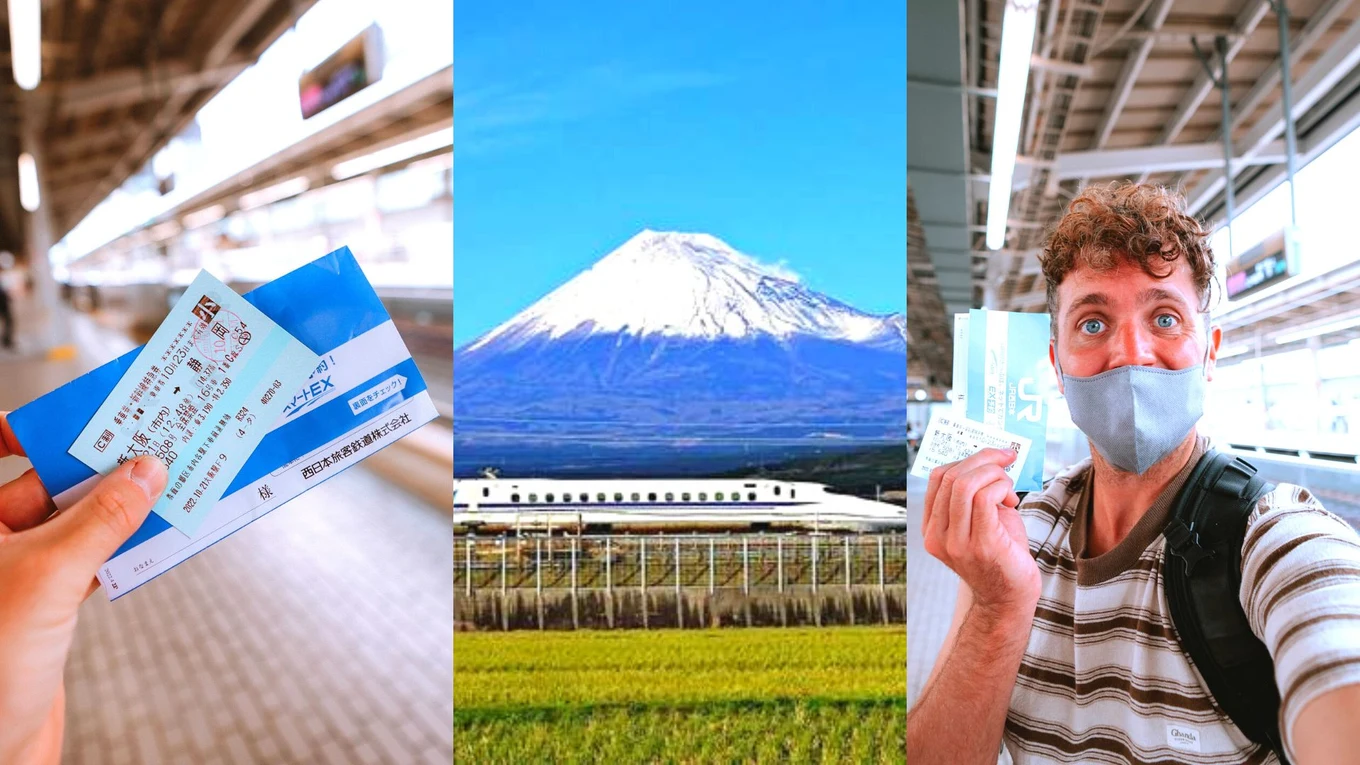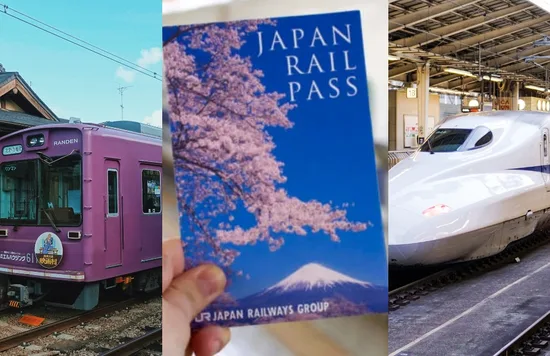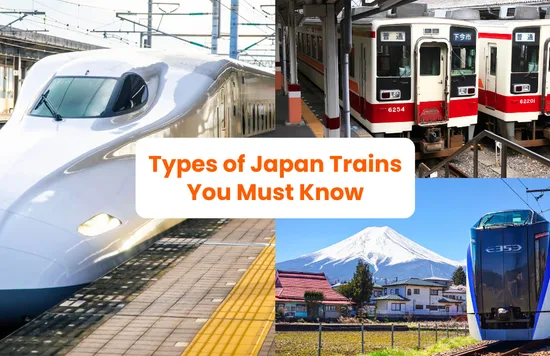The Japan Rail Pass: Your Ticket to Unlimited Travel in Japan
Getting ready to visit Japan and wanna travel around to different regions and cities? You should consider a Japan Rail Pass. It’s a lot cheaper than buying individual one-way and return train tickets, and it saves time. Plus, the trains in Japan are quick (like, super quick!), clean and comfy.
What is the Japan Rail Pass and how does it work?
The Japan Rail Pass or JR Passes are tickets you can purchase for travel across all of Japan (aka Whole Japan JR Pass), or specific regions. Whether you want to see just a few different parts of Japan or lots, you can buy a Pass to suit your travel plans.
Pre-buying a Japan Rail pass will save you time, money and the stress of figuring out which ticket you need whenever you want to hop on the train and it offers you unlimited rides on your Japan trip.
How much does a Japan Rail Pass cost and where can I purchase it?
The cost of a Japan Rail Pass in Australia varies depending on the type of pass, seat class and the duration of validity. As of 2023, a 7-day Whole Japan Rail Pass costs around AUD 325, while a 14-day pass costs around AUD 517. These prices are subject to change and may vary depending on the exchange rate between the Australian dollar and the Japanese yen.
You can purchase a Japan Rail Pass in Australia through authorised online travel agents such as Klook.
Which train lines and routes are covered by the Japan Rail Pass?
The Japan train network is impressive—it’s a trillion times better than what we’re used to in Australia! Plus, as the country is fairly small, it makes more sense to jump around using bullet trains than to waste time sitting in airports (plus, it’s better for the environment).
You can access these different rail networks using the JR Passes. The ultimate pass is the Whole Japan Rail Pass, which you can use to explore almost all of the country!
Your JR Pass can be used for almost all trains operated by Japan Railways (JR). This includes the shinkansen or high-speed train (known to many of us as the bullet train), which is your best bet if you really want to travel long distances across Japan.
What really makes the JR Pass bonzer deal is that it also lets you hop on the N'EX (Narita Express), limited express, local trains, and other networks, as long as they’re run by Japan Railways. You can even board the Tokyo Monorail to/from Haneda Airport for a breezy airport transfer.
There are so many variations of the JR Pass— this may seem confusing at first, but it actually makes the JR Pass good value as you can pretty much buy the exact ticket you’ll need with limited wastage.
For example, if you’re travelling to Tokyo and then skiing in Sapporo, you don’t need to buy a Whole Japan JR Pass, just grab the JR East—South Hokkaido Pass, which includes these two cities.
The JR Pass is also beneficial for travellers who will be basing themselves in a major city and taking their own day trips out of that city and then back again. The incredibly efficient public transport system in Japan means you really do not need a car to visit regional areas.
Can I use the Japan Rail Pass for other forms of transportation such as buses or ferries?
The JR Pass not only allows you to ride trains, but it also gives you access to the JR Ferry in Miyajima and local JR buses. There aren’t very many of these buses, but if you’re touring, you’ll find them very convenient, especially if you’re going to Kyoto, Yamaguchi, Lake Towadam and more.
#KlookTip: Learn more about the country’s transportation system with this Japan transportation guide:
Is the JR Pass worth it?
Whether or not a Japan Rail (JR) Pass is worth it depends on your travel itinerary and budget. There’s a JR Pass usage calculator that calculates how much money you can save with the pass. Simply add your points of interest to the JR Fare Calculator and you can decide if the Japan Rail Pass is worth it yourself!
Still undecided? Check out our comprehensive guide on why the JR Pass is worth it:
Am I eligible to use a JR Pass?
Only visitors who are non-Japanese passport holders and who are not permanent residents of Japan are eligible to use a Japan Rail Pass.
When you arrive in Japan, be sure to receive a Temporary Visitor Stamp at immigration so that you can prove your eligibility for the JR Pass. This is an important step for being able to pick up your JR Rail Pass.
How can I get a JR Pass shipped to Australia?
Booking your JR Pass is easy. Once you have decided which pass you need, simply click on the relevant options on the app, and your Exchange Order will be mailed to you in Australia without any delivery fee if you book on Klook.
In the booking process, when it asks for a “Redemption Date,” select the date you intend to exchange your Exchange Order for the JR Pass in Japan. Also, make sure the information you enter is exactly as it appears on your passport—the Japan Rail authorities will check this!
It’s important that you book your JR Pass at least fourteen business days before your leave for Japan to ensure your Exchange Order arrives in time. The earlier, the better! #snailmail
What is the difference between national and regional passes?
While the Whole Japan JR Pass is the main national pass that allows you access across regions, you can also opt to get ones that only cover a specific region. This is especially great if you plan to explore only a specific region, Kyushu, East Japan, Hokkaido, and heaps more!
Here's a list of regional passes you can book:
How do I know which JR Pass to book?
This is the fun part—planning your itinerary!
If you are a planner and you know exactly where you want to go, and how long you will be spending in each region, you won’t have any problems picking the right pass. This handy interactive map makes it easy to figure out which JR Pass you’ll need—simply select the cities you want to visit.
For example, if you’re planning to travel nationwide, it’s best to purchase the Whole Japan Rail Pass, which gives you access to every JR line throughout Japan.
However, if you’re only looking to travel citywide, then purchasing a single city pass might be more suitable. Head to Klook’s JR Pass booking page and simply pop in where you plan to go, and the relevant JR Passes for you will come up. Simples.
If you’re planning a trip to Osaka and want to explore nearby Nagoya during your stay, then purchase the JR Takayama-Hokuriku Area Tourist Pass. Don’t be put off by the tricky names—for the above itinerary, just tick Osaka and Nagoya as destinations you want to visit on this JR Pass page, and boom—the right ticket comes up.
Or if you’re only looking to travel within one region, like Hokkaido, then purchase the JR Hokkaido Rail Pass.
If you’re looking to do a 2-week trip to Tokyo but have planned a whole bunch of smaller day trips or overnighters to other parts of the country during your stay, then purchase the 14-day Whole Japan Rail Pass! Japan is small enough to do this quite easily.
When should I buy my JR Pass?
Given that your Exchange Voucher needs to be shipped to your home, it’s best to purchase your JR Pass at least fourteen business days before your trip. Once you’re in Japan, you can exchange it for your actual JR Pass.
What are the exact days my JR Pass is valid for?
It depends on which one you’re getting. If you’re getting the Whole Japan JR Pass, you can pick between a 7-day, 14-day or 21-day package. Some regional passes have validities of five or six days. Make sure to check the deets of the pass you’re booking to know the validity!
Can I get a refund on my JR Pass?
The answer is YES! That is if you haven’t exchanged or used your Exchange Vouchers. The JR Pass Exchange Voucher can be refunded within 12 months (1 year) of the purchase date.
What is the difference between the JR Pass Ordinary and the JR Pass Green?
When you book your JR Rail Pass online, you will be asked if you prefer a Green Car or Ordinary Car pass. The Green Cars on JR-run trains are essentially like Business Class. However, the standard of Ordinary Cars is so high that the differences are only very slight.
You will be more than comfortable in an Ordinary Car, however, in a Green Car, your seat will be bigger and softer, and they will recline. There will also be fewer seats per carriage with more room for luggage. Green Cars tend to be quieter than Ordinary Cars as there aren’t as many passengers.
On the downside, you need to book your seat each time you travel in a Green Car, which means you lose little freedom and flexibility if your plans change. Having said that, if you hold a Green Car ticket, you can still jump in the Ordinary Car—so there’s always that option for last-minute itinerary changes!
How do I use the JR Pass exchange voucher?
After booking, you will receive in the mail what is called an Exchange Order. This is NOT your JR Pass. A JR Pass can only be activated once you have entered the country because you need to have a Temporary Visitor Stamp, which you will receive at immigration.
To turn your Exchange Order into a JR Pass, you will need to take it, your Temporary Visitor Stamp and your physical passport (no photocopies) to a JR Pass Exchange Office.
Don’t worry about finding one – there will be at least one JR Pass Exchange Office in every major airport in Japan, as well as dozens of others in train stations and other places, too. You can find the closest one to you by doing a quick Google search after you have planned your arrival destination, or see the full list of JR Pass Exchange Offices here.
Do I need to activate my JR Pass on the day I exchange my voucher?
After you order your JR Pass, and are mailed your Exchange Order to your home address in Australia, you will have six months in which to make the exchange. Once you’ve done this, you do not need to use your JR Pass as soon as you receive it. Remember, you can only activate the JR pass once you’ve entered Japan.
When exchanging your Exchange Order for a JR Pass, you choose your start date. This date will be the official date your JR Pass will be active for use, so do plan out your trip and choose wisely! The start date can be any day within 30 days.
How do I use my JR Pass when I'm in Japan?
JR Pass holders do not go through the automatic gates. Instead, you’ll have to pass through the manned gate and present your pass to the staff. On certain occasions, you might also need to present your passport with your JR Pass.
Do I need to reserve seats with the JR Pass?
The answer is yes… and no. Let us explain.
This really depends on which train you’re boarding. Local and rapid JR trains have no reserved seating. Shinkansens (or bullet trains) are another story. Some of them are all reserved seating, like a plane. Some have mixed cars, meaning some sections are reserved seating while others are not. You can easily find signs in and out of the train to know which section you’re supposed to be in.
Tip: You can reserve a seat on any Shinkansen train. Just take your pass to a JR office, and voila—you’ve got yourself a reserved seat.
That’s a lot of info…Top three takeaways?
If you’re a bit more goldfish than memory genius— these are your three key takeaways for how to use the JR Pass:
- A JR Pass is good value if you’re planning to visit a few cities in Japan
- Remember to get a Temporary Visitor Stamp at immigration when you arrive in Japan
- Your Exchange Order is not your JR Pass. You will need to collect this at a JR Pass Exchange Office when you arrive in Japan.
Updated by: Rohana Monzon













































